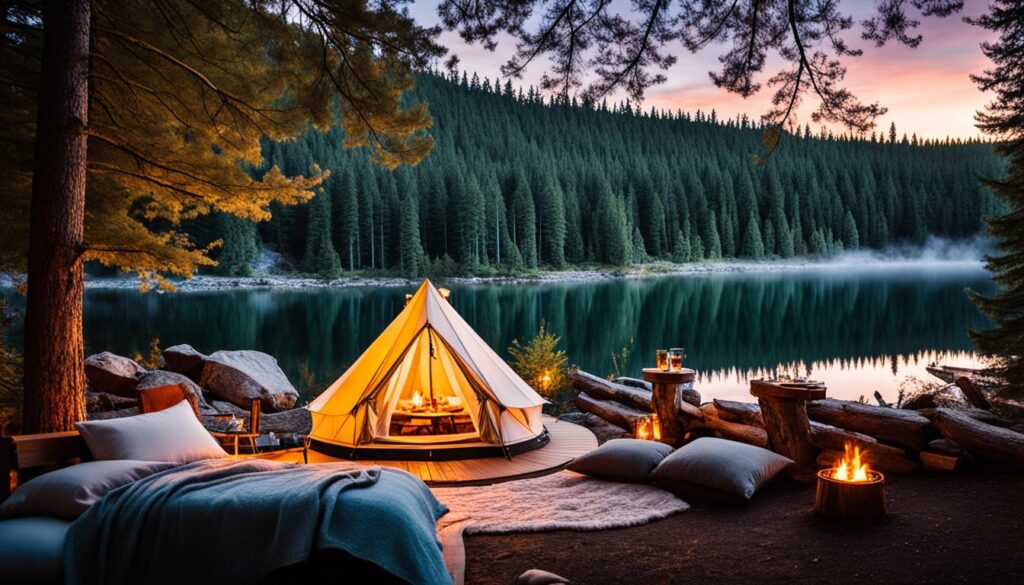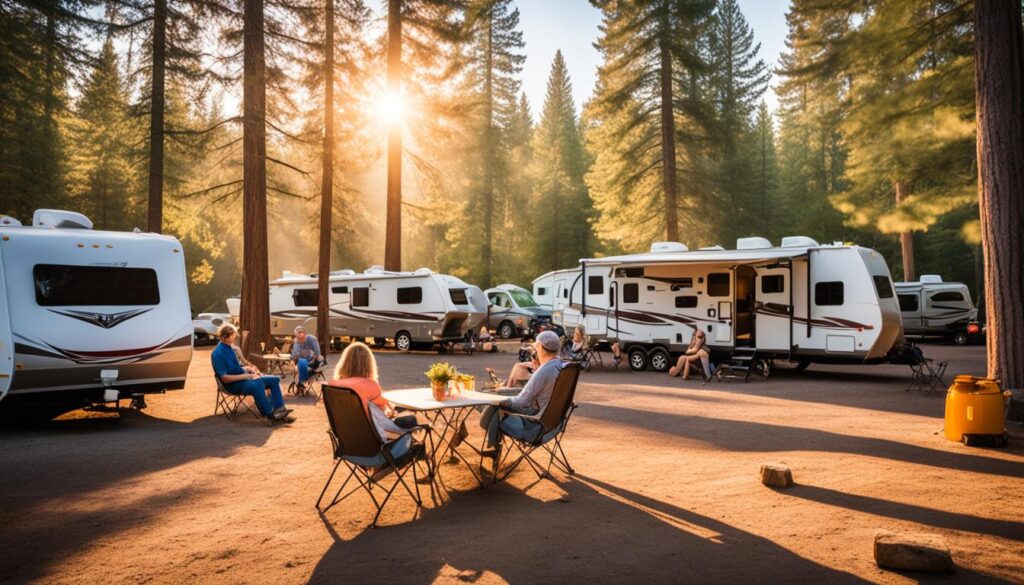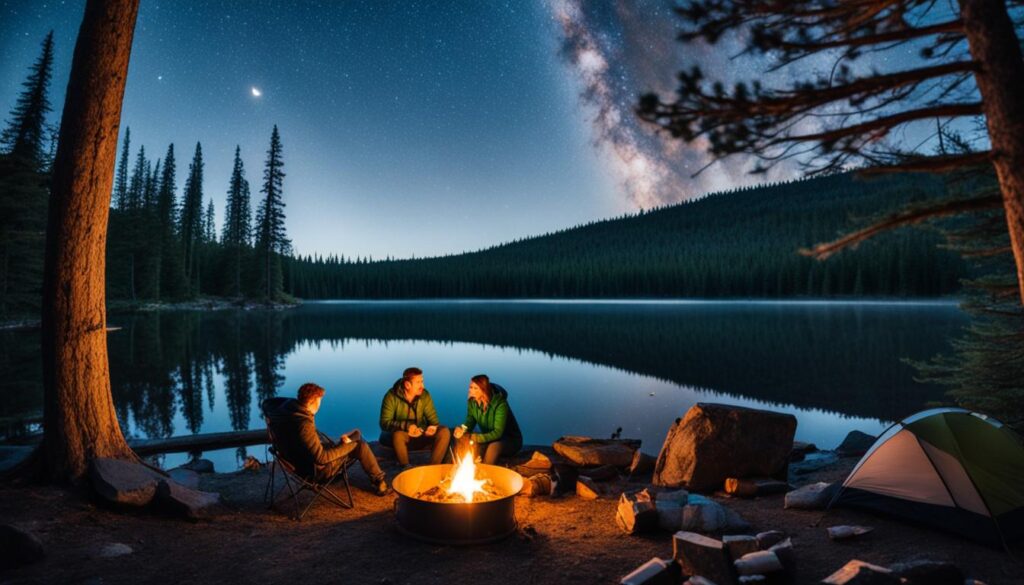Are you intrigued by the idea of camping but not quite ready to rough it out in the wilderness? Glamping might be the perfect solution for you. Glamping, short for glamorous camping, offers a luxurious and comfortable camping experience in picturesque settings. Whether you’re a nature enthusiast or simply looking for a unique vacation, glamping allows you to immerse yourself in the great outdoors without sacrificing modern comforts.
But where do you begin as a beginner? In this guide, I’ll provide you with essential tips and advice to help you embark on your glamping journey. From choosing the right gear to finding beginner-friendly destinations, I’ll cover everything you need to know to start glamping like a pro.
Glamping Essentials for Beginners: Before you delve into the world of glamping, it’s important to gather the necessary essentials. A checklist of glamping essentials will help ensure you have everything you need for a comfortable and enjoyable experience. From cozy bedding to portable heaters, these items will make your glamping adventure a memorable one.
Beginner-Friendly Glamping Destinations: Not all glamping sites are created equal when it comes to catering to beginners. Some sites offer a more rustic experience, while others provide a combination of luxury and convenience. I’ll highlight some of the best beginner-friendly glamping destinations across the United States, where you can ease into the glamping lifestyle with ease.
Glamping Tips for Beginners: Glamping is a unique experience that requires some know-how to fully enjoy. From packing smart to embracing nature, I’ll share valuable tips and tricks to help you make the most of your glamping adventure.
Best Glamping Gear for Beginners: Investing in the right gear is essential for a successful glamping trip. I’ll guide you through the must-have gear and equipment that will enhance your comfort and convenience while immersing yourself in nature.
Glamping Hacks for Beginners: Who doesn’t love a good hack? I’ll reveal some ingenious glamping hacks that will save you time, money, and make your glamping experience even more enjoyable. From DIY lighting solutions to easy meal planning ideas, these hacks will elevate your glamping game.
Be prepared to step into a world of luxury and adventure with glamping. Whether you’re a newbie or an experienced camper looking for a change, glamping offers an exciting and comfortable alternative to traditional camping. Follow my tips and advice, and you’ll be well on your way to becoming a glamping pro.
Key Takeaways:
- Glamping, short for glamorous camping, combines the beauty of nature with modern comforts.
- Glamping essentials include cozy bedding, portable heaters, and other items for a comfortable experience.
- Choose beginner-friendly glamping destinations for a seamless glamping experience.
- Glamping tips and hacks will enhance your overall experience and make it more enjoyable.
- Invest in the right glamping gear to optimize your comfort and convenience.
Contents
- 1 What is Glamping?
- 2 Profit and Investment of Glamping Business
- 3 How Big is The Glamping Market?
- 4 Glamping Business Models Options
- 5 Building a Glamping Site and Applying for Land Permissions
- 6 Researching and Choosing the Best Glamping Tent
- 7 Planning the Infrastructure and Decorating the Glamping Tent
- 8 Glamping Business Profitability and Advantages
- 9 Conclusion
- 10 FAQ
- 11 Source Links
What is Glamping?
Glamping, short for glamorous camping, offers a modern twist to traditional camping by providing upscale accommodations with amenities such as beds, Wi-Fi, and restrooms. Glamping sites focus on creating an eco-friendly environment and promoting sustainable tourism practices. The demand for glamping accommodations is driven by travelers who want to enjoy the beauty of nature while still having access to luxury amenities.
Glamping combines the allure of the great outdoors with the comfort and convenience of a hotel stay, providing a unique and immersive experience for travelers. Instead of roughing it in a tent, glampers can enjoy a cozy bed, stylish furnishings, and even gourmet dining options. This modern camping trend has gained popularity worldwide, attracting adventurers and nature enthusiasts who seek a more comfortable and luxurious way to connect with nature.
Glamping accommodations are designed to be eco-friendly, utilizing sustainable materials and practices to minimize the impact on the environment. From solar-powered energy systems to composting toilets, glamping sites strive to provide a comfortable experience while prioritizing sustainability. By opting for eco-friendly accommodations, glampers can enjoy the beauty of nature without harming the environment.
Sustainable tourism is a key concept in the glamping industry. Glamping sites often prioritize local sourcing, support local communities, and offer activities that showcase the natural and cultural heritage of the area. This focus on sustainable tourism not only benefits the local economy and environment but also provides travelers with enriching experiences and a deeper connection to the destinations they visit.
Glamping offers a unique combination of glamour and nature, providing a luxurious way to enjoy the great outdoors while minimizing environmental impact. It is the perfect choice for travelers who want to immerse themselves in nature without sacrificing comfort and sustainability.
Glamping is suitable for a wide range of travelers, from couples seeking a romantic getaway to families looking for a memorable vacation. With its blend of modern comforts and natural beauty, glamping offers an unforgettable experience that allows guests to relax, recharge, and reconnect with nature.
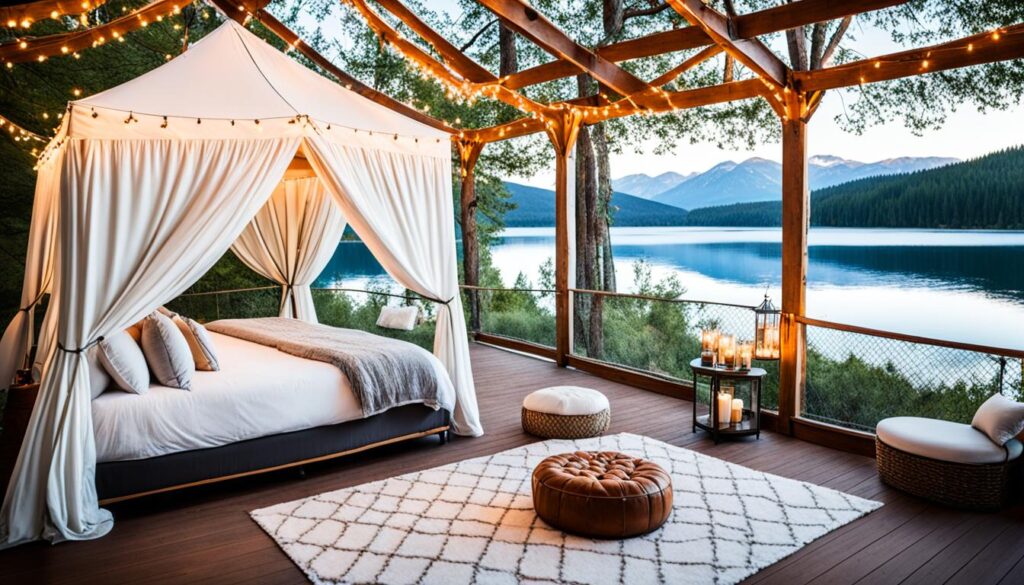
| Key Features of Glamping | Benefits of Glamping |
|---|---|
| Upscale accommodations with amenities | A unique and memorable experience |
| Eco-friendly infrastructure and practices | Minimal impact on the environment |
| Focus on sustainable tourism | Supports local communities and economies |
| Wide range of destinations and styles | Flexible options for different travel preferences |
Profit and Investment of Glamping Business
A glamping business has the potential to generate significant profits by offering guests unique and luxurious camping experiences. By charging guests for the use of glamping tents, entrepreneurs can create a steady stream of revenue. However, starting a glamping business requires careful financial planning and investment. Let’s explore the costs involved and the earning potential of a glamping business.
Cost of Starting a Glamping Business
To start a glamping business, you must consider various expenses that contribute to the initial investment. These include:
- Purchasing Glamping Tents: The cost of glamping tents can vary depending on their size, quality, and design. Investing in high-quality tents is crucial to provide guests with a comfortable and luxurious experience.
- Acquiring Land: Finding the right piece of land for your glamping site is essential. Factors such as location, accessibility, and scenic beauty contribute to the overall appeal of your business.
- Property Taxes: Owning land for your glamping business may involve regular property tax payments. It’s important to consider these taxes as part of your ongoing operational costs.
- Maintenance Costs: Maintaining the glamping site and its amenities, including tents, landscaping, and utilities, requires regular expenses.
- Labor Costs: Depending on the size and scale of your glamping business, you may need to hire staff for various roles, such as site maintenance, guest services, and housekeeping.
Proper financial planning and budgeting are key to estimating these costs accurately and ensuring that you have the necessary funds to start and sustain your glamping business.
Earning Potential of a Glamping Business
The earning potential of a glamping business depends on various factors, including:
- Number of Tents: The more glamping tents you have on your site, the greater your earning potential. Increasing the number of available accommodations allows you to serve more guests simultaneously.
- Rental Rates: Setting competitive rental rates that align with the market and the experience you offer is crucial. Balancing affordability with the unique luxury features of glamping is key to attracting guests.
- Occupancy Rate: Maximizing the occupancy rate of your glamping site is essential for revenue generation. Effective marketing strategies, positive guest experiences, and repeat bookings contribute to a higher occupancy rate.
With careful planning, effective marketing, and exceptional guest experiences, a well-managed glamping business can turn a significant profit. The growing demand for unique outdoor experiences and sustainable tourism ensures a promising market for glamping entrepreneurs.
Image: 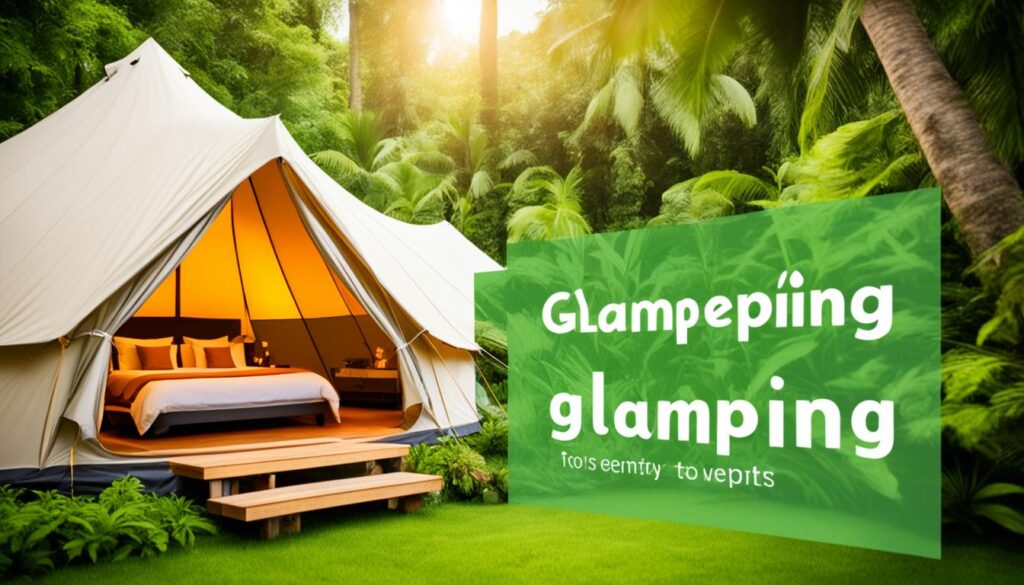
How Big is The Glamping Market?
The global glamping market is experiencing significant growth and is projected to reach billions of dollars in the coming years. This growth can be attributed to several key factors driving the glamping market.
- Increasing consumer demand for unique experiences: Travelers today are seeking new and unconventional ways to connect with nature and enjoy outdoor experiences. Glamping offers the perfect blend of luxury and adventure, allowing guests to immerse themselves in breathtaking natural surroundings while enjoying upscale accommodations and amenities.
- Growing interest in sustainable tourism: As awareness of environmental issues continues to rise, there is a growing emphasis on sustainable tourism practices. Glamping provides eco-friendly accommodations that minimize the impact on the environment, making it an attractive option for environmentally conscious travelers.
- Availability of diverse accommodation options: Glamping offers a wide range of accommodation options to suit different preferences and budgets. From luxurious safari tents to cozy treehouses and stylish yurts, there is something for everyone. This variety of choices caters to the evolving needs and preferences of travelers.
- Rising disposable income levels: As disposable income levels increase worldwide, people have more financial freedom to indulge in unique and memorable travel experiences. Glamping allows them to enjoy the best of both worlds – the thrill of outdoor adventure combined with the comforts of a luxury retreat.
- Interest in wellness retreats: The glamping market has also benefited from the growing interest in wellness retreats. Many glamping sites offer amenities and activities that promote relaxation, rejuvenation, and overall well-being, attracting wellness-oriented travelers seeking an escape from the hustle and bustle of daily life.
- Influence of social media platforms: The rise of social media platforms has significantly impacted the glamping market. Travelers today are seeking Instagram-worthy experiences and are actively sharing their glamping adventures on social media. This exposure not only fuels the growth of the glamping market but also inspires others to seek similar extraordinary experiences.
Overall, the glamping market is thriving due to the convergence of these key factors. As more people seek unique, sustainable, and luxurious outdoor experiences, the glamping industry is poised for continued growth in the coming years.
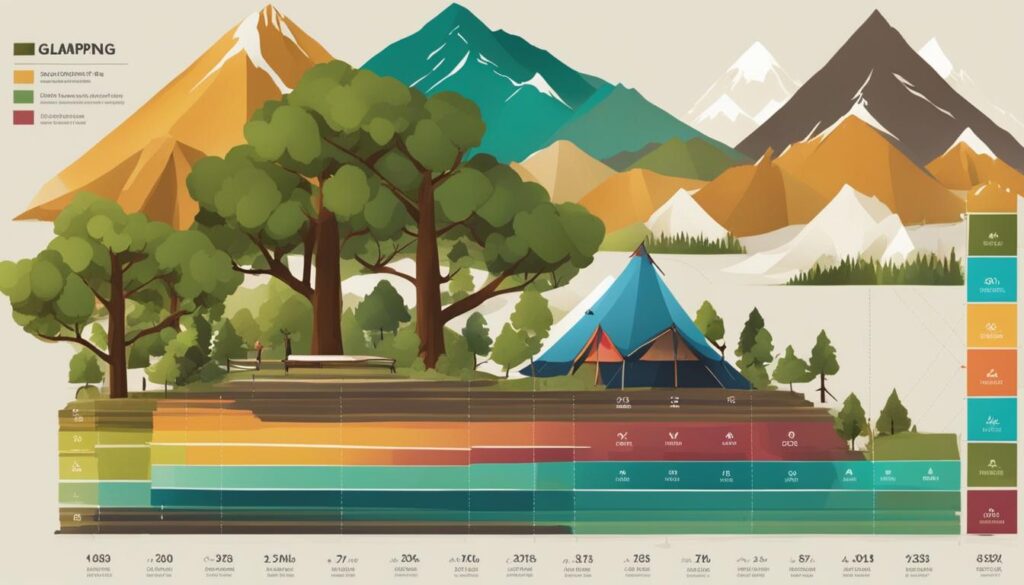
Glamping Business Models Options
When it comes to operating a successful glamping business, there are various business models to consider. Each model has its own advantages and costs, allowing entrepreneurs to choose the one that aligns best with their goals and preferences. Let’s explore three popular glamping business models: franchise, corporate, and private ownership.
Franchise Glamping Business
A franchise glamping business involves partnering with an established glamping brand and operating under their name and guidelines. By franchising, entrepreneurs benefit from the brand reputation, proven business model, and marketing support provided by the franchisor.
Advantages:
- Access to a recognized brand and established customer base
- Support and training from the franchisor
- Shared marketing and advertising costs
Costs:
- Franchise fees and ongoing royalties
- Less autonomy in decision-making
- Adhering to the franchisor’s guidelines and standards
Corporate Glamping Business
A corporate glamping business involves establishing and operating a glamping site as a subsidiary of a larger company. This model allows for more control and flexibility in decision-making, while benefiting from the resources and support of the parent company.
Advantages:
- Independence in decision-making and branding
- Access to resources and support from the parent company
- Potential for synergies with other business divisions
Costs:
- Initial investment and ongoing operational costs
- Responsibility for marketing, branding, and operations
Private Ownership Glamping Business
A private ownership glamping business involves starting and operating a glamping site independently. This model offers the greatest level of control and ownership over the business, allowing entrepreneurs to fully implement their vision and brand.
Advantages:
- Complete ownership and control of the business
- Freedom to develop a unique brand and customer experience
- Flexibility in decision-making and operations
Costs:
- Initial investment for land, tents, and infrastructure
- Responsibility for all aspects of the business, including marketing and operations
As the glamping industry continues to evolve, new business models may emerge to cater to the changing market demands. It’s important for entrepreneurs to carefully evaluate their investment capital, ownership preferences, and desired level of support when choosing a glamping business model.
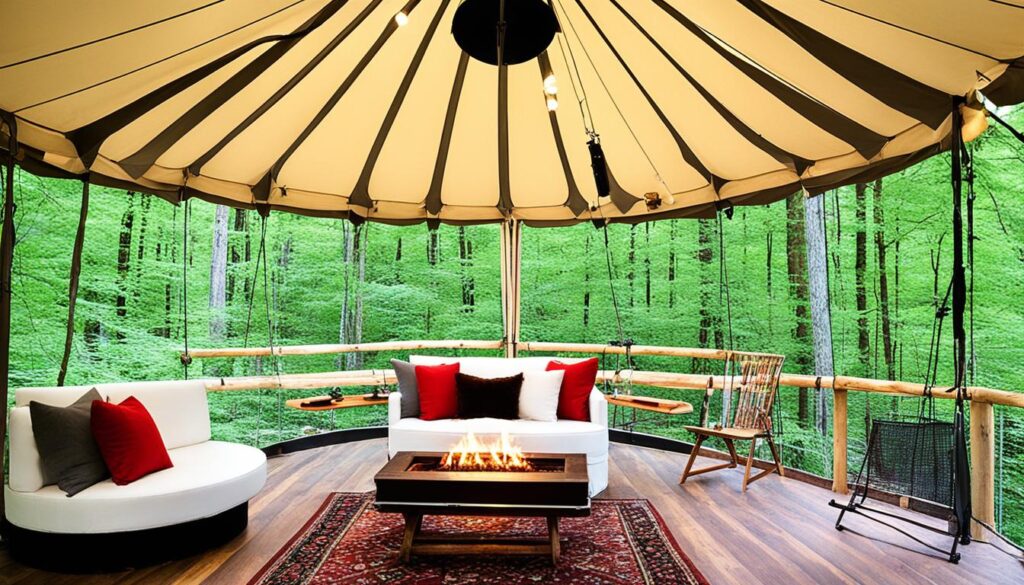
Building a Glamping Site and Applying for Land Permissions
When it comes to starting a glamping business, one of the crucial steps is choosing the right location for your glamping site. The location plays a significant role in attracting customers and creating a memorable experience. Consider factors such as scenic beauty, convenient transportation options, and accessibility to nearby attractions.
However, before you can start building your glamping site, it’s important to obtain the necessary land permissions and planning permissions. The requirements for land permissions may vary depending on the country or region where you plan to operate your glamping business. Failure to comply with regulations can result in fines or even the termination of your business.
To ensure a smooth process, I recommend consulting with local authorities and understanding the specific land permission requirements for your chosen glamping site location. This may involve acquiring permits, licenses, and other legal documentation to demonstrate that your glamping business adheres to all relevant laws and regulations.
Additionally, obtaining planning permission is crucial to ensure that your glamping site meets all local zoning and building regulations. Depending on the location and the type of glamping site you want to create, you may need to submit a detailed plan, including site layout, infrastructure plans, and environmental impact assessments.
By diligently following the necessary procedures for land permissions and planning permissions, you can establish your glamping site on solid legal ground and avoid any legal troubles down the line.
Benefits of Consulting with Local Authorities
Consulting with local authorities when building your glamping site and applying for land permissions can provide valuable insights and guidance throughout the process. Local officials can help you understand the specific regulations, permits, and licenses required for your glamping business to operate legally.
Here are some key benefits of consulting with local authorities:
- Understanding zoning requirements: Local authorities can provide information about zoning requirements specific to your chosen location, ensuring that your glamping site falls within the designated land use category.
- Ensuring compliance with building codes: Local building codes exist to ensure the safety and structural integrity of buildings. Consulting with local authorities will help you understand and adhere to these codes during the construction phase of your glamping site.
- Gaining insights on environmental regulations: Glamping sites often operate within natural environments. Local authorities can provide guidance on any environmental regulations you may need to comply with to ensure the preservation and sustainability of your chosen location.
- Discovering additional permits and licenses: Local authorities can inform you of any additional permits or licenses you may need based on the unique features and amenities you plan to offer at your glamping site, such as food service permits or liquor licenses.
By collaborating with local authorities, you can navigate the complex process of obtaining land permissions and planning permissions with confidence, ensuring a smooth and successful start for your glamping business.
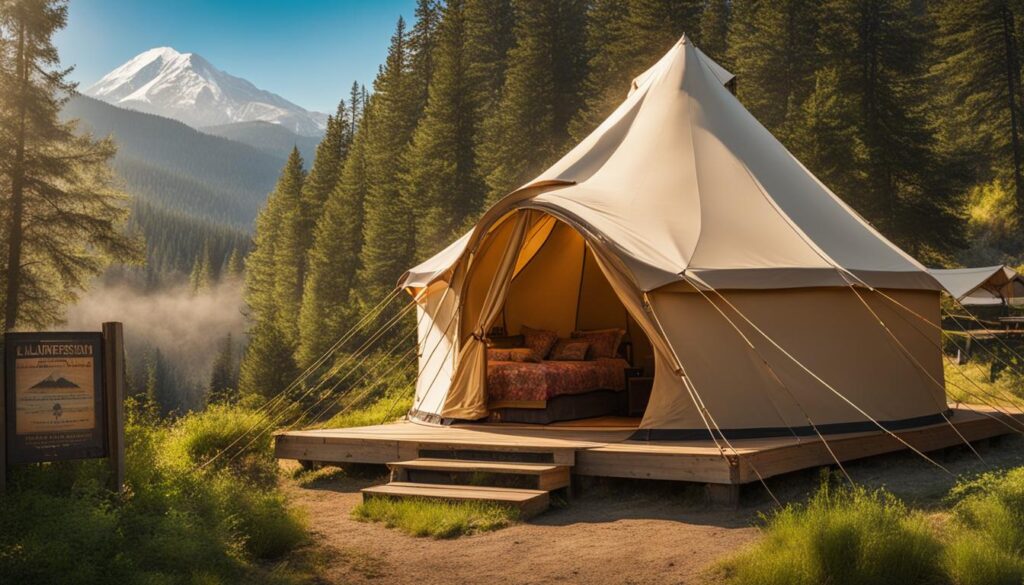
Researching and Choosing the Best Glamping Tent
When it comes to starting a successful glamping business, one of the most important decisions you’ll make is selecting the right glamping tent. With a wide range of options available, from yurts and tipis to caravans and treehouses, it’s crucial to do thorough research and carefully consider the features that will best suit your business and guests.
Here are some key factors to consider when choosing a glamping tent:
- Size: Determine the number of guests you want to accommodate and choose a tent size accordingly. Consider the space needed for comfortable sleeping arrangements, storage, and additional amenities.
- Style: Different glamping tent styles offer unique aesthetics and design elements. Consider the ambiance and experience you want to create for your guests and choose a style that aligns with your vision.
- Durability: Glamping tents should be built to withstand various weather conditions and heavy use. Look for tents made from high-quality materials that offer durability and longevity.
- Ease of Assembly: Opt for tents that are relatively easy to assemble and disassemble. This will save time and effort when setting up and taking down the tents between guests.
- Amenities: Consider the amenities you want to provide in your glamping tent, such as beds, seating areas, electricity, heating, air conditioning, and en-suite bathrooms. Choose a tent that allows for the integration of these amenities.
Investing in a high-quality, well-designed glamping tent will not only enhance the experience for your guests but also contribute to the overall success of your glamping business. Remember to consider factors such as size, style, durability, ease of assembly, and amenities when making your selection.
Image: Choosing the Right Glamping Tent

| Tent Type | Description |
|---|---|
| Yurt | A circular tent traditionally used by nomads in Central Asia, offering a spacious and versatile accommodation option. |
| Tipi | A conical tent with a rich Native American history, known for its unique shape and cozy interior. |
| Caravan | A retro-style camper trailer that allows for easy mobility and provides a compact yet comfortable living space. |
| Treehouse | An elevated accommodation option that combines the beauty of nature with the allure of a cozy, rustic retreat. |
| Tiny House | A small, fully furnished and functional house that offers a minimalist and sustainable glamping experience. |
Each glamping tent type has its own unique charm and appeal. Consider the desired guest experience and the specific features offered by each tent type before making your final decision.
Planning the Infrastructure and Decorating the Glamping Tent
Once you have acquired your glamping tent, it is important to meticulously plan the infrastructure and carefully design the interior to provide a comfortable and unique experience for your guests. The right amenities and facilities can make a significant difference in enhancing their stay and leaving a lasting impression.
Consider the following key aspects when planning the infrastructure of your glamping tent:
- Electricity: Providing electricity within the tent allows guests to conveniently charge their devices and enjoy modern comforts. It is essential to ensure safe and efficient electrical wiring and outlets, considering the specific power requirements of your amenities and appliances.
- Plumbing: Depending on the type of glamping tent and the level of luxury you aim to offer, you may consider incorporating a private bathroom or a designated washing area within the tent. Plumbing systems should be expertly installed to uphold hygiene standards.
- Heating and Cooling Systems: To provide a comfortable environment throughout the year, consider installing heating and cooling systems. This helps guests feel cozy in colder months and ensures a pleasant temperature during hotter periods.
Furthermore, paying attention to the decoration and furnishings of your glamping tent is essential in creating an inviting and memorable ambiance:
- Furnishings: Carefully select furniture that complements the style and theme of your glamping site. Comfortable beds, seating arrangements, and storage options can greatly enhance the comfort and convenience of your guests.
- Decor: Use decor elements such as rugs, curtains, cushions, and artwork to create a cozy and visually appealing space. Incorporating elements of nature, like botanical prints or natural textures, can harmoniously blend the outdoor atmosphere with the interior design.
- Outdoor Spaces: Designate outdoor areas near the glamping tent for relaxation and recreation. Furnishing these spaces with seating, fire pits, or picnic tables allows guests to fully immerse themselves in the tranquility of nature.
Remember, the goal is to provide a seamless fusion of luxury and nature, ensuring your guests have an unforgettable glamping experience. Take inspiration from successful glamping sites and stay updated with the latest design trends to create an atmosphere that stands out.
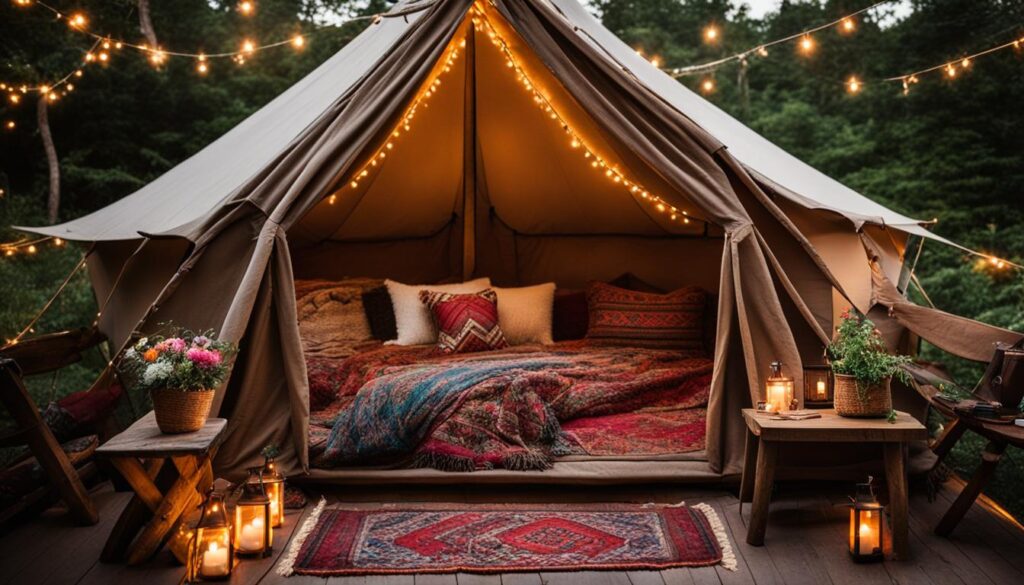
Glamping Business Profitability and Advantages
When it comes to starting a business in the hospitality industry, glamping offers a profitable opportunity with several advantages. Glamping businesses have lower startup costs compared to traditional vacation rentals, making them an attractive option for entrepreneurs looking to enter the market. The initial investment in glamping tents and land is generally more affordable, allowing for quicker returns on investment and increased profitability.
The demand for unique accommodations and sustainable tourism experiences is on the rise, making glamping a popular choice among travelers. By combining luxury amenities with the beauty of nature, glamping appeals to those seeking an eco-friendly and immersive getaway. The growing interest in eco-friendly glamping and nature tourism further contributes to the profitability of glamping businesses.
One of the advantages of owning a glamping business is the opportunity for a flexible work-life balance. Unlike traditional hospitality businesses that require constant on-site management, glamping businesses can be operated remotely, allowing owners to enjoy freedom and flexibility in their work schedules.
Furthermore, owning a glamping business provides a platform to showcase the beauty of nature to travelers. By creating a unique and memorable experience, glamping businesses contribute to the promotion of sustainable tourism and a deeper appreciation for the environment. Glamping allows guests to reconnect with nature without compromising on comfort, creating a win-win situation for both business owners and travelers.
“Glamping offers a profitable opportunity with lower startup costs and the chance to showcase the beauty of nature to travelers.”
| Advantages | Description |
|---|---|
| Lower Startup Costs | Compared to traditional vacation rentals, glamping businesses have lower initial investment requirements, resulting in quicker returns on investment. |
| Increase in Demand | Glamping caters to the growing demand for unique accommodations and sustainable tourism experiences, ensuring a steady stream of potential customers. |
| Flexible Work-Life Balance | Owning a glamping business allows for location independence and the ability to manage operations remotely, providing a flexible work schedule. |
| Showcase Nature’s Beauty | Glamping businesses provide a platform to promote sustainable tourism and connect guests with the natural environment while offering luxurious amenities. |
Conclusion
Starting a glamping business can be a rewarding venture for those interested in providing luxurious camping experiences to travelers. By carefully planning, conducting thorough research, and making strategic investments, beginners can enter the glamping market and potentially earn significant profits.
The glamping market is experiencing significant growth, driven by consumer demand for unique experiences and sustainable tourism options. Travelers are seeking accommodations that allow them to enjoy the beauty of nature while still providing access to luxury amenities. By understanding the different glamping business models, staying updated on market trends, and considering customer preferences, beginners can navigate the glamping industry successfully.
Key tips for a successful glamping business include choosing the right location, obtaining the necessary land permissions, selecting the best glamping tents, planning the infrastructure and interior design, and providing a cozy and inviting atmosphere for guests. Additionally, maintaining a focus on eco-friendly practices and promoting nature tourism can further enhance the appeal of a glamping business.
With the growing popularity of glamping and the potential for substantial profits, individuals who are passionate about offering unique and luxury camping experiences have a lucrative opportunity to establish successful glamping businesses. By implementing the tips and strategies outlined throughout this article, entrepreneurs can position themselves for success in the thriving glamping market.
FAQ
What is glamping?
Glamping, short for glamorous camping, offers a modern twist to traditional camping by providing upscale accommodations with amenities such as beds, Wi-Fi, and restrooms. Glamping sites focus on creating an eco-friendly environment and promoting sustainable tourism practices.
Is starting a glamping business profitable?
Yes, a glamping business can generate revenue by charging guests for the use of the glamping tents. The income potential of a glamping business depends on factors such as the number of tents, rental rates, and occupancy rate. With proper planning and management, a glamping business can be profitable in the long run.
How big is the glamping market?
The global glamping market is projected to reach billions of dollars in the coming years, with a compound annual growth rate (CAGR) of 12.4% from 2024 to 2032. The market is driven by increasing consumer demand for unique experiences, growing interest in sustainable tourism, and the availability of diverse accommodation options.
What are the different business models for a glamping business?
The different business models for operating a glamping business include franchise, corporate, and private ownership. Each model has its advantages and costs, and the choice depends on factors such as investment capital, ownership preferences, and desired level of support.
How do I choose the right location for my glamping site?
When choosing a location for a glamping site, consider factors such as scenic beauty, convenient transportation, and accessibility to attractions. It is important to obtain land permissions and planning permissions, which may vary depending on the country or region. Consult with local authorities and obtain all necessary permits and licenses before starting a glamping business.
What should I consider when choosing a glamping tent?
When choosing a glamping tent, consider factors such as size, style, durability, ease of assembly, and amenities. There are various types of glamping tents available, such as yurts, tipis, caravans, treehouses, and tiny houses. Investing in high-quality, well-designed tents will enhance the guest experience and contribute to the success of the glamping business.
What is involved in planning the infrastructure and decorating the glamping tent?
Planning the infrastructure of a glamping tent involves considerations such as amenities like electricity, plumbing, heating and cooling systems, as well as furnishings, decor, and outdoor spaces. Creating a cozy and inviting atmosphere will attract guests and ensure their satisfaction during their glamping experience.
Are glamping businesses profitable?
Yes, glamping businesses offer lower startup costs compared to traditional vacation rentals, making them a profitable option for entrepreneurs. The lower costs, coupled with the growing demand for unique accommodations and sustainable tourism, contribute to the profitability of glamping businesses.
How can I start a glamping business?
Starting a glamping business requires careful planning, research, and investment. Beginners can enter the glamping market by understanding the business models, market trends, and customer preferences, and then navigating the glamping industry to establish successful glamping businesses.
What are the advantages of owning a glamping business?
Owning a glamping business allows for a flexible work-life balance and provides the opportunity to showcase the beauty of nature to travelers. Glamping businesses also contribute to sustainable tourism and offer unique experiences to guests who want to enjoy both luxury and the beauty of nature.
